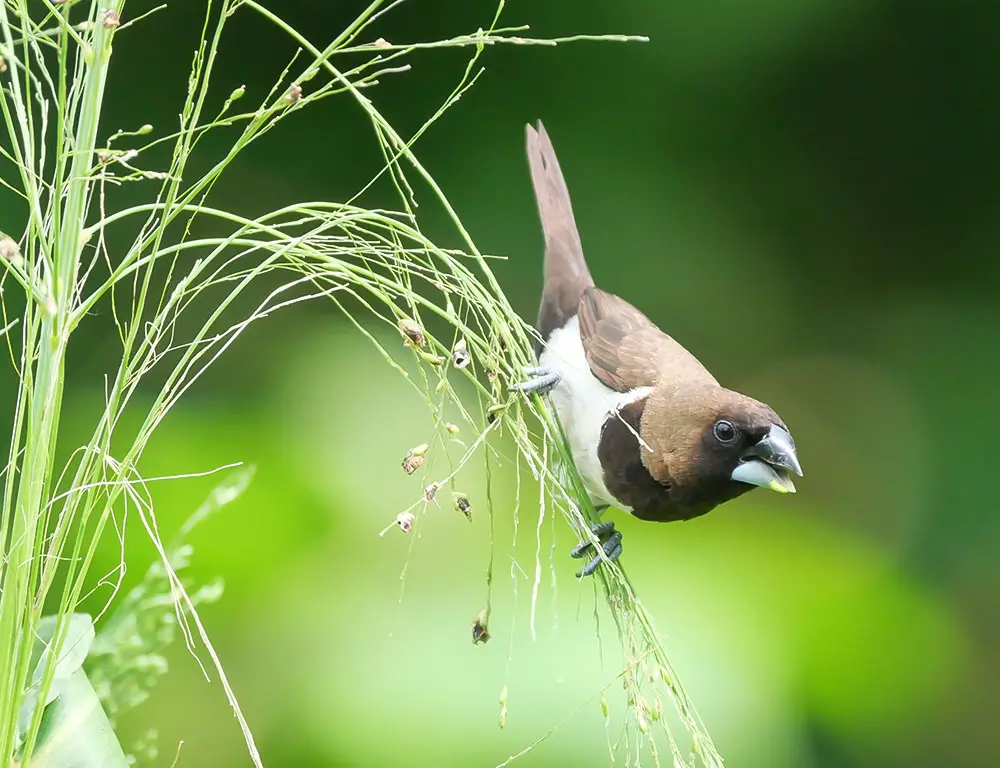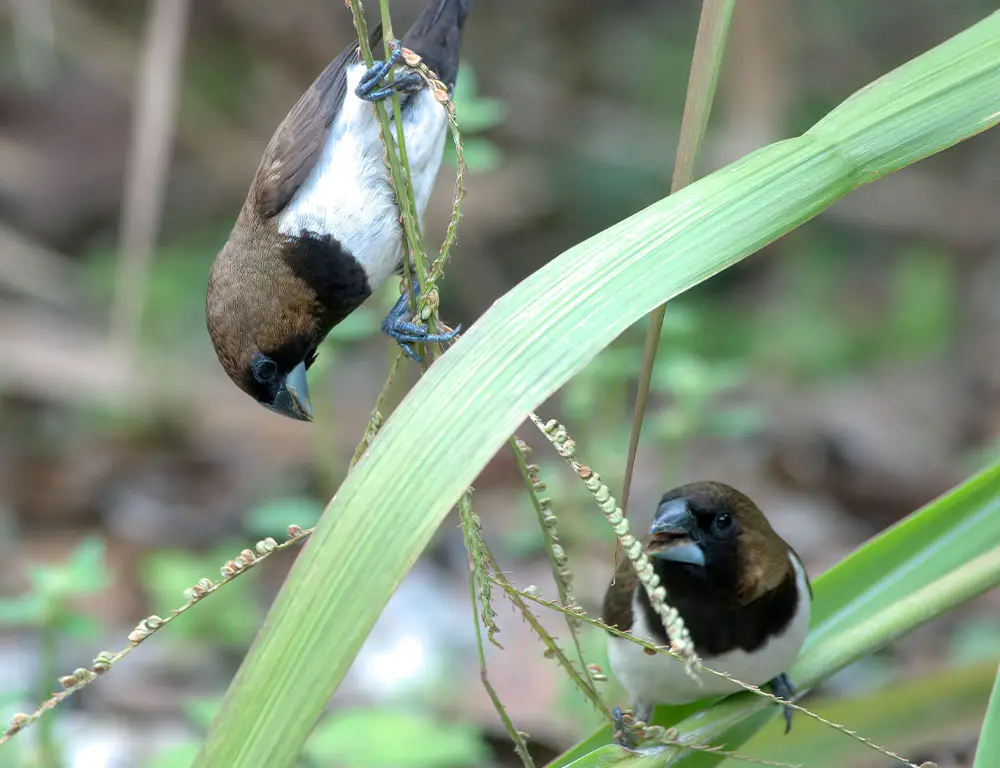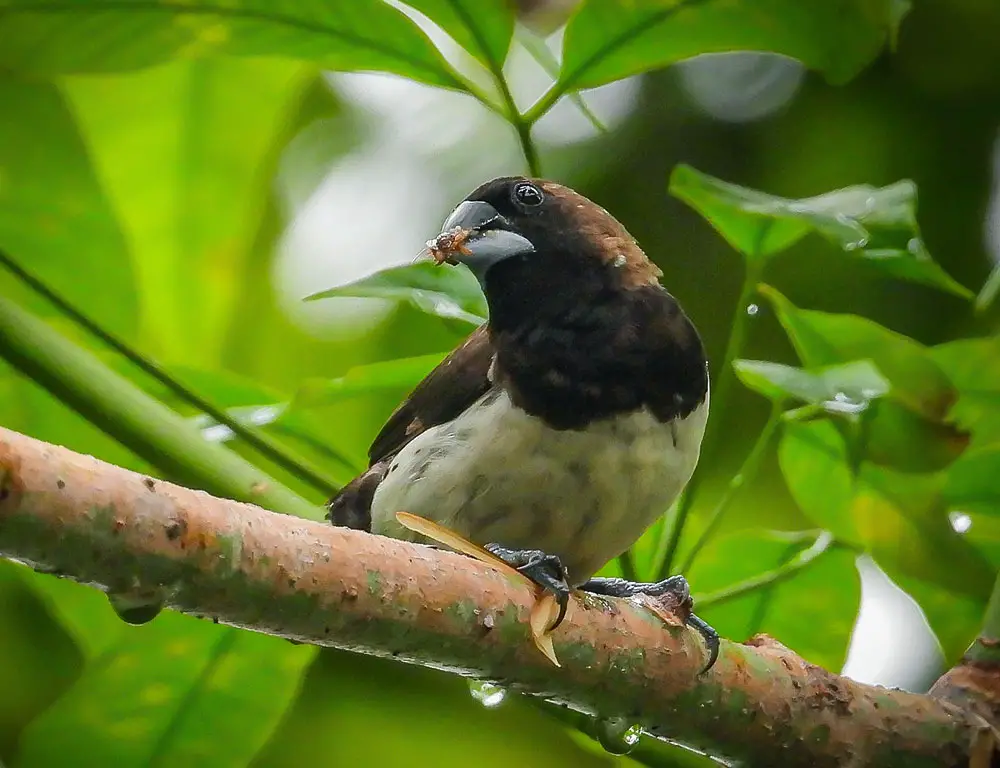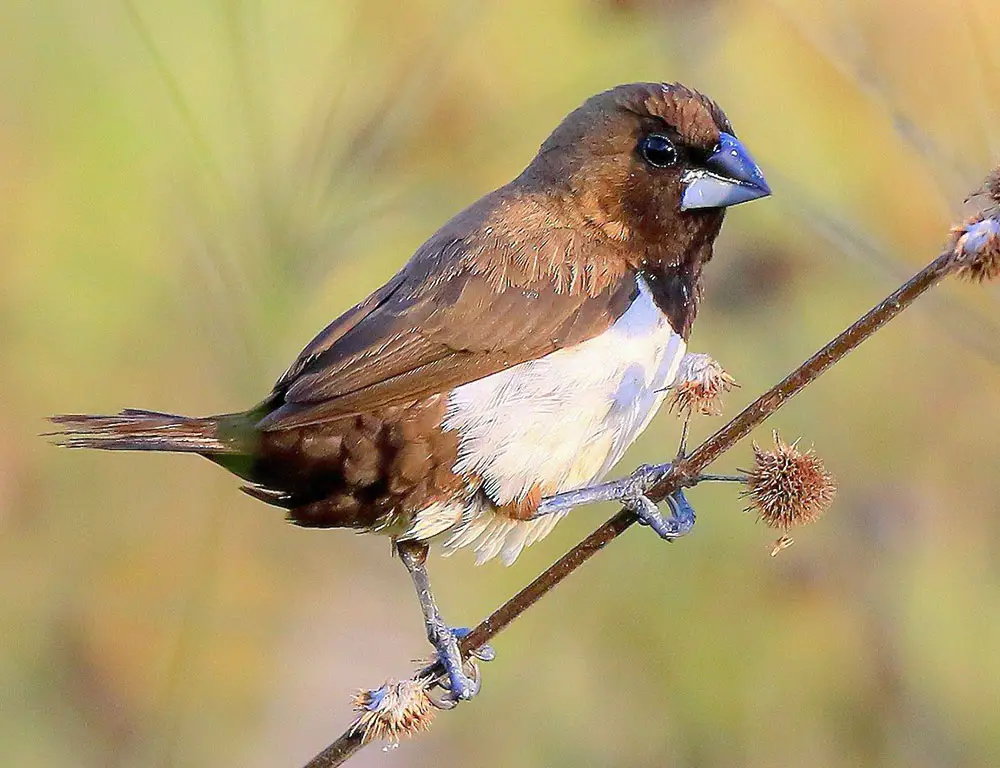Discover the captivating world of the Javan Munia, a fascinating bird species native to the Indonesian island of Java. With its striking black and white plumage set against warm brown wings, this small finch captures the attention of bird enthusiasts worldwide.
Yet, its allure extends beyond its appearance; researchers are drawn to the Javan Munia for its intriguing social habits and complex communal nesting structures.
Unlike many avian species, these birds thrive in large groups, harmoniously sharing resources and supporting one another. Delving into their behavior and habitat reveals a captivating story of cooperation and adaptation.
Join us as we unravel the mysteries of the Javan Munia, offering insights into why it remains a compelling subject for ornithologists globally.

Physical Characteristics of Javan Munia
The Javan Munia (Lonchura leucogastroides) is a small bird native to the Indonesian islands of Java and Bali. Its distinct physical characteristics contribute to its unique appearance and ecological niche.
Here are the key physical traits of the Javan Munia:
Size
The Javan Munia is relatively small, measuring around 11-12 centimeters (4.3 – 4.7 inches) in length from beak to tail tip. Despite its small size, it is agile and energetic.
Plumage
A striking contrast of colors characterizes the plumage of the Javan Munia. Its upper body is covered in rich brown feathers, often with black patterns on the wings and back. The underbelly and tail underside are typically white, contrasting with the darker plumage.
Beak
Like many finch species, the Javan Munia has a small, conical beak adapted for feeding on seeds and grains. Its sharp beak enables it to crack open seeds and extract the nutritious contents precisely.
Eyes
The Javan Munia’s eyes are typically dark-colored, set against an eye-ring that may display an attractive shade of red. This feature adds to the bird’s aesthetic appeal and serves practical purposes, such as enhancing visual acuity.
Gender Dimorphism
Unlike some bird species where males and females exhibit distinct differences in plumage coloration, Javan Munias shows minimal sexual dimorphism.
Both males and females share similar coloring, making it challenging to differentiate between the sexes based solely on physical appearance.
Adaptations for Habitat
The physical characteristics of the Javan Munia are well-suited to its natural habitat, which includes grasslands, agricultural fields, and open woodlands. Its small size and agile movements enable it to navigate through dense vegetation, searching for food and nesting sites.
Habitat and Distribution of Javan Munia

The Javan Munia (Lonchura leucogastroides), a captivating bird species indigenous to the Indonesian islands of Java and Bali, exhibits remarkable adaptability to various habitats.
Here’s a closer look at its habitat and distribution:
Natural Habitat
- Grasslands: Javan Munias thrive in grassland habitats, where they can be found foraging for seeds amidst tall grasses. These open areas provide ample opportunities for feeding and nesting.
- Agricultural Fields: With a particular fondness for rural landscapes, including rice and wheat fields, Javan Munias are often called “rice birds.” They feed on grains and insects found in these cultivated areas.
- Gardens and Parks: Besides natural habitats, Javan Munias is known to inhabit urban and suburban environments, including gardens, parks, and green spaces. They adapt well to human-altered landscapes, finding food and shelter amidst vegetation.
Geographic Distribution
- Native Range: The Javan Munia’s primary range encompasses the Indonesian Java and Bali islands. These islands offer a variety of habitats, from lowland grasslands to agricultural fields, suitable for the bird’s survival.
- Southeast Asia: While their primary distribution is concentrated in Java and Bali, Javan Munias has also established populations in other parts of Southeast Asia, including Singapore and Malaysia. They demonstrate the ability to adapt and thrive in diverse regional environments.
- Introduced Populations: Beyond Southeast Asia, Javan Munias has been successfully introduced to other regions worldwide, such as Australia and Puerto Rico. These introductions highlight the bird’s adaptability to new habitats and ability to establish stable populations outside its native range.
Preferred Habitat Features
- Vegetation Cover: Javan Munias prefers habitats with ample vegetation, including tall grasses, bushes, and trees. These provide both food resources and nesting sites for the birds.
- Water Sources: Water bodies, such as ponds, rivers, and irrigation channels, are often found near Javan Munia habitats. These serve as important landmarks and provide drinking water for the birds.
Behavior of the Javan Munia: Feeding, Nesting, and Communal Roosting

The behavior of the Javan Munia encompasses a range of fascinating traits, from its feeding habits to its nesting behavior and communal roosting tendencies.
Let’s explore these aspects in more detail:
Feeding Habits
- Seed Predation: Javan Munias are primarily seed eaters with a particular fondness for grass seeds. Their small size and sharp beaks enable them to extract seeds from grass seed heads efficiently, even amidst dense vegetation.
- Dietary Variety: While grass seeds are preferred, they also consume other seeds, such as millet and grains, including rice grains, when available. This dietary flexibility allows them to adapt to changing food availability in their environment.
- Group Feeding: Javan Munias often feeds in flocks, a behavior that aids in detecting potential threats and covering larger foraging areas more efficiently. Group feeding also provides social opportunities for the birds to interact with one another.
Nesting Behavior
- Nest Construction: Javan Munias are meticulous nest builders, crafting intricate nests from fine strands of grass and twigs. These nests are typically built low in bushes or trees, often near water sources for added protection against predators.
- Monogamous Breeding: During the breeding season, Javan Munias form monogamous pairs, with one male partnering with one female. Both parents actively participate in nest building and care for the young, showcasing cooperative parental behavior.
- Egg Characteristics: The eggs of Javan Munias are typically pale blue or white with reddish-brown spots scattered over them, adding to the aesthetic appeal of their nesting sites. Clutch sizes vary but commonly range between four to seven eggs per nesting period.
Communal Roosting
After the breeding season, multiple pairs of Javan Munias come together to form large groups for communal roosting. This behavior serves various purposes: warmth, safety, and social interaction. Witnessing hundreds of these tiny birds huddling together at nightfall is a remarkable spectacle.
Conservation Status of Javan Munia

The Javan Munia, Lonchura leucogastroides, is currently assessed as “Least Concern” by the International Union for Conservation of Nature (IUCN). This designation indicates that the species is not facing an immediate risk of extinction.
However, several factors threaten the long-term survival of the Javan Munia population, warranting ongoing conservation efforts:
Habitat Loss
Rapid urbanization and agricultural expansion have led to the loss and degradation of the Javan Munia’s preferred habitats, including grasslands, swamps, and cultivated fields. The steady increase in habitat loss over the years poses a significant threat to the species’ survival.
Illegal Pet Trade
Javan Munia’s striking plumage and social behaviors make it a target for the illegal pet trade. Despite legal protections, many individuals are captured from the wild and sold as pets, further impacting wild populations.
Conservation Efforts
Conservation efforts aimed at addressing these threats include:
- Habitat Protection: Establishing protected areas and conservation reserves to safeguard critical habitats for Javan Munias and other wildlife species.
- Law Enforcement: Strengthening enforcement of laws and regulations to combat illegal trade and protect Javan Munias from exploitation.
- Community Engagement: Engaging with local communities to raise awareness about the importance of conserving Javan Munias and their habitats and promoting sustainable land use practices.
- Research and Monitoring: Research to better understand the ecology and behavior of Javan Munias and monitor population trends to inform conservation efforts.
FAQs
Do Javan Munia birds migrate?
Javan Munia birds are generally sedentary, meaning they do not undertake long-distance migrations. They may exhibit local movements in response to environmental changes.
How do Javan Munia birds communicate?
Javan Munia birds communicate through various vocalizations, including chirps, trills, and melodious calls used for mate attraction, territorial defense, and social bonding.
What predators do Javan Munia birds face?
Javan Munia birds face predation from birds of prey like hawks and owls, snakes, and mammals such as cats and rats.
How do Javan Munia birds contribute to ecosystem health?
Javan Munia birds contribute to ecosystem health by dispersing seeds, aiding in plant diversity, and supporting habitat regeneration through their foraging behavior.
How can I attract Javan Munia birds to my garden?
To attract Javan Munia birds to your garden, provide dense shrubs for nesting, bird feeders with seeds, grains, and fresh water sources.
Conclusion
The Javan Munia emerges as a captivating subject of study, showcasing its remarkable adaptation to Indonesia’s diverse landscapes. Its vibrant plumage, intricate nesting habits, and friendly nature underscore its significance in avian ecology.
While currently classified as of “Least Concern” status, the species faces looming threats, particularly habitat loss, necessitating ongoing conservation efforts.
As stewards of our natural world, we must recognize and safeguard the invaluable contributions of species like the Javan Munia to ecosystem diversity.
We can inspire collective action to ensure their continued presence in our shared environment by fostering a deeper appreciation for these feathered marvels. Let us embrace our role in preserving the rich tapestry of life, with the Javan Munia occupying a prominent place within it.